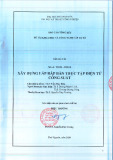
BioMed Central
Page 1 of 11
(page number not for citation purposes)
Theoretical Biology and Medical
Modelling
Open Access
Research
A computational model for functional mapping of genes that
regulate intra-cellular circadian rhythms
Tian Liu1, Xueli Liu1, Yunmei Chen2 and Rongling Wu*1
Address: 1Department of Statistics, University of Florida, Gainesville, FL 32611, USA and 2Department of Mathematics, University of Florida,
Gainesville, FL 32611, USA
Email: Tian Liu - tianliu@stat.ufl.edu; Xueli Liu - xueli@stat.ufl.edu; Yunmei Chen - yun@math.ufl.edu; Rongling Wu* - rwu@stat.ufl.edu
* Corresponding author
Abstract
Background: Genes that control circadian rhythms in organisms have been recognized, but have
been difficult to detect because circadian behavior comprises periodically dynamic traits and is
sensitive to environmental changes.
Method: We present a statistical model for mapping and characterizing specific genes or
quantitative trait loci (QTL) that affect variations in rhythmic responses. This model integrates a
system of differential equations into the framework for functional mapping, allowing hypotheses
about the interplay between genetic actions and periodic rhythms to be tested. A simulation
approach based on sustained circadian oscillations of the clock proteins and their mRNAs has been
designed to test the statistical properties of the model.
Conclusion: The model has significant implications for probing the molecular genetic mechanism
of rhythmic oscillations through the detection of the clock QTL throughout the genome.
Background
Rhythmic phenomena are considered to involve a mecha-
nism, ubiquitous among organisms populating the earth,
for responding to daily and seasonal changes resulting
from the planet's rotation and its orbit around the sun [1].
All these periodic responses are recorded in a circadian
clock that allows the organism to anticipate rhythmic
changes in the environment, thus equipping it with regu-
latory and adaptive machinery [2]. It is well recognized
that circadian rhythms operate at all levels of biological
organization, approximating a twenty-four hour period,
or more accurately, the alternation between day and night
[3]. Although there is a widely accepted view that the nor-
mal functions of biological processes are strongly corre-
lated with the genes that control them, the detailed
genetic mechanisms by which circadian behavior is gener-
ated and mediated are poorly understood [4].
Several studies have identified various so-called circadian
clock genes and clock-controlled transcription factors
through mutants in animal models [5,6]. These genes
have implications for clinical trials: their identification
holds great promise for determining optimal times for
drug administration based on an individual patient's
genetic makeup. It has been suggested that drug adminis-
tration at the appropriate body time can improve the out-
come of pharmacotherapy by maximizing the potency
and minimizing the toxicity of the drug [7], whereas drug
administration at an inappropriate body time can induce
more severe side effects [8]. In practice, body-time-
dependent therapy, termed chronotherapy [9], can be
Published: 30 January 2007
Theoretical Biology and Medical Modelling 2007, 4:5 doi:10.1186/1742-4682-4-5
Received: 8 October 2006
Accepted: 30 January 2007
This article is available from: http://www.tbiomed.com/content/4/1/5
© 2007 Liu et al; licensee BioMed Central Ltd.
This is an Open Access article distributed under the terms of the Creative Commons Attribution License (http://creativecommons.org/licenses/by/2.0),
which permits unrestricted use, distribution, and reproduction in any medium, provided the original work is properly cited.






























